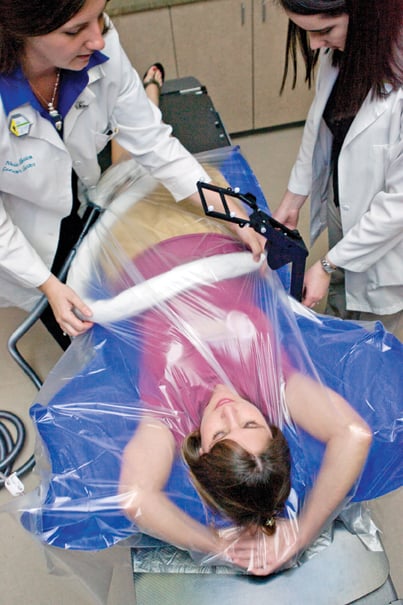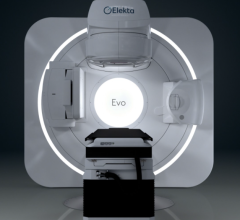
As radiation therapy treatments evolve, radiation therapists are assuming more responsibilities. Their core duties still include serving as the primary contact for patients undergoing radiation therapy treatments that can last several weeks and administering the actual treatments. However, therapists also must review protocols, monitor and assess patients and stay up-to-date on technological advances in equipment. The necessity to balance duties in their “high-tech/high-touch” profession makes radiation therapists a unique breed in the radiologic sciences.
Even as they take on more tasks, therapists have to maintain a high level of accuracy, follow established radiation safety protocols and make sure their patients feel comfortable and at ease. It is a mammoth job. But the nearly 20,000 registered radiation therapists in the United States continue to accept the challenge.
The American Society of Radiologic Technologists (ASRT), which represents close to 15,000 radiation therapy professionals, knows that therapists’ jobs will continue to get more complex. As a result, the ASRT Education and Research Foundation, the group’s philanthropic arm, and its Health Care Industry Advisory Council developed a subcommittee to address the challenges faced by therapists and equipment manufacturers. The goal was to develop a white paper featuring a series of concrete best practices and recommendations for radiation therapists to incorporate into their daily workplace processes.
Consisting of radiation therapists, managers and equipment manufacturers, the Subcommittee on Patient Safety and Quality in Radiation Therapy met at the ASRT office in Albuquerque, N.M., in November 2011 to discuss challenges and develop workable solutions for radiation therapists and vendors. The group focused on four areas in the radiation therapy environment: workplace staffing, workplace culture, skills assessment, and applications training and support.
This diverse group of professionals brought an effective mix of opinions, knowledge and expertise to the table. Practicing radiation therapists provided real-world working experiences; managers offered key insights into effective and ineffective processes and procedures, and vendors outlined the ideal scenarios for effective applications training. They evaluated the challenges therapists and vendors face in delivering quality care and providing top-notch equipment training, and they developed tangible steps to solve some of the common workplace issues.
Need for More Staffing, Less Fear of Reprimand in Reporting Errors
Starting with workplace staffing, the group looked at a number of factors facing radiation therapists, including patient workload, daily responsibilities and new technology. In addition, the subcommittee examined research statistics focusing on workplace staffing issues and recommendations from accredited radiation therapy programs.
For example, guidelines outlined in accreditation programs consistently recommend staffing of two therapists per active linear accelerator, regardless of patient volume. In addition, the guidelines stress the need to add more therapists to the staff, depending on the annual number of new patients at a facility and the ratio of procedures performed.
Yet, in a 2010 ASRT survey of radiation therapists and dosimetrists, 10 percent said only one therapist staffed a treatment machine for eight hours each day. This shortcoming was a factor in the subcommittee’s decision to develop a best practice that states all sites providing radiation should staff at the level of two therapists per machine at all times.
With regard to workplace culture, discussion topics included the role of communication on the treatment team, the therapist’s critical role in safeguarding the patient and reporting of errors. In reviewing research studies, which provided data about current workplace culture trends, one statistic that caught the group’s attention came from a study about radiation therapy error reporting, presented at the 2011 ASRT Radiation Therapy Conference. According to the survey, only 78 percent of respondents strongly agreed that they are encouraged to report clinical errors. In addition, the survey reported that fear of reprimand is the greatest barrier to error reporting.
As a result, the subcommittee developed three best practices. The first focuses on developing a culture that supports radiation therapist professionalism. The second outlines the importance of adhering to standards of practice, and the third encourages consistent reporting of errors.
Skills Assessment Required Prior to Training
The subcommittee spent a significant amount of time discussing skills assessment. Assessing the skill level of radiation therapists before they participate in equipment training is extremely important to employers, because if therapists don’t have a solid grasp of the basics of the equipment, training can’t move forward in an effective manner.
To ensure that radiation therapists understand the basics of the technology, the group established a best practice that urges employers to work with applications trainers to develop checklists to conduct preassessments of a radiation therapist’s skills before beginning applications training and to complete postcompetency assessments after training. Secondly, the subcommittee encourages radiation oncology providers to conduct ongoing peer-to-peer assessments.
Since the subcommittee included equipment manufacturer representatives who specialize in training, the applications training and support topic garnered a lot of attention. Applications training helps staff members become well versed and comfortable with new equipment and technologies in their departments, so they can safely operate it.
Unfortunately, with increasing workloads and added responsibilities, members of the treatment team frequently view it as a task that stops productivity and hinders performance. In addition, radiation therapy departments can have different types of equipment on site, so multiple training sessions are sometimes necessary. This adds to the time commitment for training.
Knowing that effective applications training can help radiation therapy departments improve patient care, the group developed two clear best practices that encourage teamwork. The first directs radiation therapy managers, radiation therapists and vendor representatives to work together to help ensure successful implementation and training for sites purchasing new radiation therapy equipment. The second asks vendors to cooperate to improve multivendor implementation, training and support.
Encouraging Best Practices
The Health Care Industry Advisory Council hopes therapists and equipment applications trainers will work together to implement the white paper’s best practices and recommendations, incorporating them into the treatment team’s daily work processes. These clear-cut guidelines provide treatment team members with a blueprint to increase efficiency and enhance patient safety.
The complete white paper is available at www.asrtfoundation.org/safetyintherapywhitepaper. A quick summary of the council’s best practices is in the sidebar below.
Jake Buehler is director of public relations for the American Society of Radiologic Technologists.
SIDEBAR:
Best Practices for Radiation Therapists
Following is a summary of the best practices for radiation therapy safety, developed by the American Society of Radiologic Technologists’ Education and Research Foundation Health Care Industry Advisory Council, released earlier this year.
Workplace Staffing:
• All radiation therapy is delivered only by American Registry of Radiologic Technologists (ARRT)-registered radiation therapists.
• All sites providing radiation therapy staff at the level of two therapists per machine at all times.
Workplace Culture:
• Administrators, radiation oncologists, radiation therapists and all oncology staff members embrace a culture that supports radiation therapist professionalism.
• Radiation therapists and other radiation oncology professionals adhere to professional ethics and standards of practice established by their professions.
• Reporting of errors is expected and encouraged.
Skills Assessment:
• Employers conduct preassessments of radiation therapists’ skills before beginning applications training and postcompetency assessments following training.
• Radiation oncology providers conduct ongoing peer-to-peer assessment.
Applications Training:
• Radiation therapy managers, radiation therapists and vendor representatives work together to help ensure successful implementation and training for sites purchasing new radiation therapy equipment.
• Vendors cooperate to improve multivendor implementation, training and support for radiation therapy sites.
For more, visit www.asrt.org


 May 17, 2024
May 17, 2024 








